A Para athlete who chooses to pursue a new sport or get involved in a second sport, or whose circumstances force them to leave their sport, is engaging in a process called “athlete transfer.” The Paralympic Athlete Transfer Task Force has undertaken research to understand athlete transfer experience and inform future policies and pathways.
Concussions are common in Para sports such as blind soccer, where collisions between players frequently occur. Research shows that despite the high concussion risk posed in blind soccer, many athletes do not feel confident in their ability to recognize a concussion. Improving concussion education, particularly around concussion symptoms, may help improve concussion recognition in this population.
Less research has focused on doping in Paralympic sport than Olympic sport. A recent study focused on Para sport coaches showed that they identify doping as an issue in Para sport and that it often stems from financial incentives and pressure to win.
Parents of athletes with disabilities face challenges like limited local sport options and funding, but they also experience benefits like social inclusion and support. Scholars suggest that sport programs should tackle these cultural and environmental barriers and actively involve parents in creating support systems. Additionally, there is a need to enhance talent identification pathways for disabled youth in sports.
Coaches play an important role in facilitating athlete development. Shepherding athletes through an introduction to Para sport after an accident is a unique coaching role. This study explores the role of wheelchair rugby coaches in the development of athletes with a spinal cord injury.
This blog is a part of a series created in collaboration with the Canadian Paralympic Committee and the Paralympic Athlete Transfer Task Force, spotlighting the opportunities and challenges of Para athlete transfer and multi-sport participation.
In 2006, Robbi Weldon came across a copy of Abilities Magazine. The front cover featured Para cyclist Brian Cowie and inside the magazine there was a feature on Para nordic skier Brian McKeever and his brother and guide, Robin McKeever. Both Brians have the same eye condition, Stargardt Disease, as Weldon.
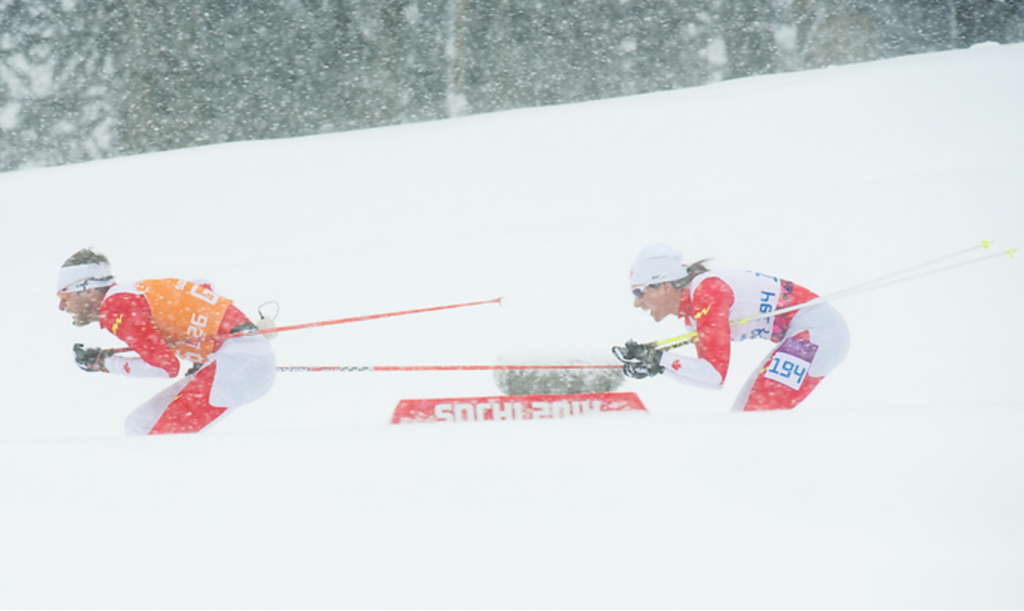
No stranger to sports (she downhill skied, played goalball and soccer, and even set world records in the sport of blind powerlifting in her youth) Weldon knew what her next challenge would be. A couple months later, she was beating the top national Para nordic athlete of the time and on track to make Team Canada at the 2010 Paralympic Games.
But her Paralympic dreams didn’t stop with Para nordic skiing. About a year after she got into the sport, the national coach for Para cycling reached out to Weldon to see if she wanted to try tandem cycling. A mere 2 weeks after her first Paralympic Games experience with the Para nordic team, Weldon followed up with Cycling Canada. And thus, her career as a dual sport athlete began.
In total, Weldon competed at 4 Paralympics—two summer and two winter. And only 6 years after flipping through that serendipitous copy of Abilities Magazine, she took home a gold medal in road cycling alongside her guide, Lyne Bessette, in 2012.
Coaching a dual sport athlete
Weldon says without question her best years on the bike were when she was also training for skiing. It took some convincing to get her cycling coach on board though.
“My cycling coach was dead set against strength training. He wanted everything on the bike. The McKeevers were into cycling, so they understood the benefit for skiing. I really had to have Robin, [who was the Para nordic coach at the time] meet with my cycling coach to talk it out,” Weldon says, “But when I stopped ski racing in 2015, my last years of cycling weren’t as strong as the first years.”
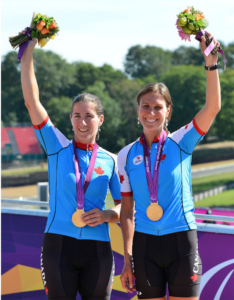 For Weldon, the challenge of being a dual sport athlete wasn’t solely balancing two training schedules, but also two kids and a job at the hospital. She needed flexible coaching that supported her as both an athlete and a parent.
For Weldon, the challenge of being a dual sport athlete wasn’t solely balancing two training schedules, but also two kids and a job at the hospital. She needed flexible coaching that supported her as both an athlete and a parent.
“The coaches had to adjust the training. I would do one training session before work and one after the kids went to bed. I brought my kids with me to training camps and that was something that the coaches were okay with,” Weldon says.
Christina Picton, a fellow dual sport athlete, agrees that coaches’ attitudes and support can make, or break, the experience of trying out a new sport. Picton has been a prominent figure in the Canadian Para ice hockey landscape since 2010. She captained the women’s national Para ice hockey team and was the first woman to try out for the men’s team.
In 2018, an athlete she was coaching in a “Learn to Sledge” program suggested she check out Para nordic. Initially rebuffing the idea, Picton, who has a congenital condition that impacted both her legs, eventually tried out the trails. Weeks later, she entered her first Para nordic ski race and a year later moved onto the international circuit, claiming a spot on Team Canada for the 2022 Paralympics.
“Tara [Chisholm], my hockey coach, saw that I had this opportunity to compete at higher levels and really improve as an athlete, and that there was a pathway to get to the Paralympic Games. She knows that’s the dream, so she was nothing but supportive,” Picton says.
Her coach on the “receiving” end, Patti Kitler, was equally supportive of Picton’s relationship with hockey, encouraging her to pursue both sports for as long as she wanted.
Transferring skills from one sport to another
Going from Para ice hockey to Para nordic, Picton says that it wasn’t just her physical skills that carried over, but the mental skills from competing at a high level in a different sport helped.
“At the Paralympics, which is something that I’ve dreamed of for many years, one of the coaches said, ‘Wow, you’re handling this so well! You don’t even seem nervous’” Picton recalls, “I was so excited to be there, but I was calm. And I think that comes from the high pressure situations I had been in through hockey.”
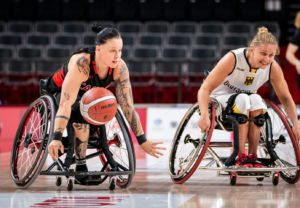 The benefits of participating in multiple sports are not lost on 5-time Paralympian and multi-sport athlete Cindy Ouellet. Ouellet already had a successful career as a 3-time Paralympian with Canada’s wheelchair basketball program when she added winter sports to her summer slate. She picked up Para nordic skiing in 2017 and progressed quickly, having skied for about a year before competing at her fourth Paralympic Games in 2018.
The benefits of participating in multiple sports are not lost on 5-time Paralympian and multi-sport athlete Cindy Ouellet. Ouellet already had a successful career as a 3-time Paralympian with Canada’s wheelchair basketball program when she added winter sports to her summer slate. She picked up Para nordic skiing in 2017 and progressed quickly, having skied for about a year before competing at her fourth Paralympic Games in 2018.
Ouellet, who is also an accomplished boxer and CrossFit athlete, is closing her journey with Para nordic for now, but not because she’s done with winter sports. Ouellet has her sights set on Para ice hockey, competing at the first-ever International Paralympic Committee-sanctioned women’s Para ice hockey tournament, the World Challenge, with Team World in August.
Like Brianna Hennessy described in a previous article, for Ouellet, the push and pull combination of wheelchair basketball and Para nordic were complementary, although she identifies as more of a power athlete. The transition to hockey has been smooth in part because the poling motion of skiing is similar to that needed to drive a sledge forward on the ice. But like wheelchair basketball, hockey is a power-oriented team sport.
“I also think my boxing and CrossFit contribute to my strength. Everything transfers in some way,” Ouellet adds, “I’m a firm believer in multi-sport and not just one specialization.”
No one right path
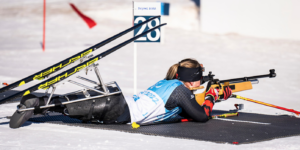 Weldon, Picton, and Ouellet have a collective 10 Paralympic appearances between them. All 3 women are multi-sport athletes from childhood and all 3 have represented Canada in Para nordic skiing.
Weldon, Picton, and Ouellet have a collective 10 Paralympic appearances between them. All 3 women are multi-sport athletes from childhood and all 3 have represented Canada in Para nordic skiing.
On the surface, their experiences with the Canadian Para sport system may sound similar. But what their stories show is that there is no single “right” way to progress through sport, be it Para or not.
“Just remember to take care of your mental health as well as your physical health to avoid burnout,” Ouellet advises, “Playing a lot of sports comes with a lot of pressure, a lot of stress, so make sure you lean on your support system, including your high performance director and your coaches and make sure everyone is on the same page.”
For other athletes considering participation in multiple sports or a transition from one sport to another, Weldon, Ouellet and Picton’s experiences speak to the importance of collaborative and flexible coach support and a sport system that empowers women athletes to reach their potential.
According to Picton, there’s no downside to trying something new.
“If you don’t try, you’ll never know, right? You might crash and burn or you might not enjoy it, but you also might find something you really love.”
For more Para athlete transfer stories, checkout our profiles on Alex Hayward, Brianna Hennessy and Liam Hickey.
The COVID-19 pandemic has limited access to athlete classification, a requirement for Para sport competition. To this end, researchers at Western University are working to develop and evaluate hybridized frameworks to deliver classification, including elements of virtual classification. The aim is to consider approaches that require few resources and create greater levels of accessibility to Para sport participation.
The #WeThe15 campaign aims to use sport to help break down barriers and end discrimination against the 15% of the world’s population that experiences disability. But some researchers argue that the campaign overlooks the exclusionary nature of certain events, such as the Paralympic Games (in which only certain bodies with disabilities are eligible to compete). They suggest moving beyond the “everyone is human” messaging towards celebration of difference.
This blog is a part of a series created in collaboration with the Canadian Paralympic Committee and the Paralympic Athlete Transfer Task Force, spotlighting the opportunities and challenges of Para athlete transfer and multi-sport participation.
When COVID-19 hit, like the rest of us, Alexandre Hayward was stuck at home. Hayward, a member of the Canadian Junior National Wheelchair Basketball team, faced the same issue that Canadian athletes of all levels and almost all sports faced: gyms, pools, rinks, and other training facilities were closed, making training difficult.
Hayward had progressed quickly through the ranks of wheelchair basketball after a spinal cord injury while playing hockey in 2012. By 2017, he was captaining the Canadian U23 national team and named Wheelchair Basketball Canada’s Junior Athlete of the Year. Stuck inside, he needed an outlet for his competitive energy.
So, he took up cycling.
“Cycling was always a secondary passion of mine when I was playing hockey, before my injury,” Hayward says. “I’m pretty ambulatory, but because of my disability, I would have a really hard time recovering. It would take me a couple days to get back to normal [after riding]. While training for wheelchair basketball, I never really had time for that.”
COVID-19 lockdowns gave Hayward that extra recovery time and cycling gave him a way to stay in shape while facilities were closed. So, for Alex’s coach, Michael “Frog” Frogley, encouraging Alex’s cycling was a no-brainer.
The more Hayward cycled, the more he liked it. And other people started to notice that he was good at it. Really good.
“Parasport New Brunswick reached out and told me they had a wheelchair basketball player from New Brunswick who just did a mountain bike race held in Fredericton and won,” Guillaume Plourde, then-coach with Cycling Canada recalls. “That got me wondering whether he could be eligible for Para cycling.”
Plourde reached out to Hayward, and shortly thereafter found himself on group calls with Frogley to discuss Hayward’s training, potential, and progression – in both sports.
Hayward is emphatic that it is the willingness of the two coaches to collaborate that fully supported his sporting experience.
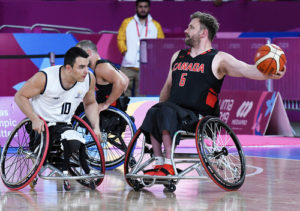 “It’s worth highlighting that I was a carded athlete for wheelchair basketball at the time that I started cycling,” Hayward says. “I don’t want to say that at the end of the day it came down to Frog and how he decided to deal with it, but it kind of did. If he had been against me trying out cycling, it would have been really hard to say no.”
“It’s worth highlighting that I was a carded athlete for wheelchair basketball at the time that I started cycling,” Hayward says. “I don’t want to say that at the end of the day it came down to Frog and how he decided to deal with it, but it kind of did. If he had been against me trying out cycling, it would have been really hard to say no.”
Denying athletes the opportunity to explore their potential, even if it means a possible talent loss to his team, goes against Frogley’s fundamental coaching philosophy.
“My philosophy is to holistically maximize the potential of the athletes and teams that I’m working with–not just their wheelchair basketball potential, but all areas of their life. I want to help them be the best student they can be, the best employee they can be, the best person they can be,” Frogley says. “I think because of this, I’m predisposed to be open with regard to athletes trying other things.”
Plourde is used to working with other coaches, as many of the athletes he trains have transferred from other sports. “Athlete transfer” is the term used to describe when a Para athlete chooses to pursue a new sport or get involved in a second sport. Plourde is aware that as cycling is most often a “receiver” sport, he’s coming from a particular side of the equation.
“At the end of the day, it’s always good for different sports to nurture positive relationships between coaches. It increases all of our knowledge and encourages us to communicate, rather than be possessive over athletes,” Plourde, who has recently taken on a new role with the Canadian Paralympic Committee, says.
Frogley, coming from the side of wheelchair basketball—a frequent “donor” sport—couldn’t agree more. In fact, he doesn’t really like the idea of “donor” sports, preferring instead to think of them as “opportunity” or “development” sports.
“I think it’s incredibly important to understand that the sport an athlete first starts in has a huge role to play,” Frogley says, “because if it’s a positive experience, that’s what keeps the athlete in sport.”
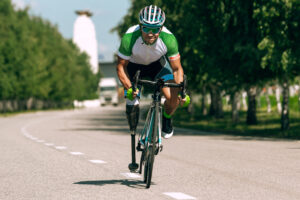 Thanks to the willingness of Plourde and Frogley to work together, Hayward balanced training for both wheelchair basketball and Para cycling, all while still pursuing his engineering degree.
Thanks to the willingness of Plourde and Frogley to work together, Hayward balanced training for both wheelchair basketball and Para cycling, all while still pursuing his engineering degree.
“Guillaume and I both really respect Alex’s school, so that was a third piece that needed to be balanced,” Frogley says.
But after focusing on wheelchair basketball full-time in Toronto last summer, Hayward started to question the best path forward for his development.
“I had the best basketball summer of my life. I was arguably the best basketball player I’ve ever been. But I just wasn’t having as much fun anymore,” Hayward says. After candid conversations with both coaches, he transferred his full attention to training solely for cycling.
At his first time trial in May, Hayward hit the standard he needed to compete nationally. At his first Nationals in June in Edmonton, Hayward showed up and surprised the field as a newcomer, winning the time trial and qualifying himself for the World Cup and World Championships in Quebec in August. With this being his first year of high-level competitive racing, Hayward describes it as a true “trial by fire.”
“I guess I’m a cyclist now,” he says with a laugh.
When it comes to Hayward, Frogley notes that it was wheelchair basketball coaches in New Brunswick that initially developed him as an athlete. Wheelchair Basketball Canada programming gave Hayward the opportunity to learn how to maximize himself physically, tactically, mentally, and be surrounded by other high performing individuals.
“All of this preparation meant that when Alex transferred over to Para cycling, he was right on to the podium track,” Frogley says, “Wheelchair basketball didn’t lose an athlete as far as I’m concerned. We contributed to an athlete’s success.”
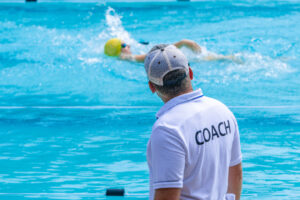 Hayward, Plourde and Frogley all wish to encourage other sport federations with frequent transfers to understand the critical role they play in providing initial opportunities. Frogley notes that like wheelchair basketball, Para swimming also has a high number of athletes who transfer: “That’s a success on their part. Without that foundational development from swimming, that athlete isn’t going to be as successful when they transfer to, say, Para triathlon.”
Hayward, Plourde and Frogley all wish to encourage other sport federations with frequent transfers to understand the critical role they play in providing initial opportunities. Frogley notes that like wheelchair basketball, Para swimming also has a high number of athletes who transfer: “That’s a success on their part. Without that foundational development from swimming, that athlete isn’t going to be as successful when they transfer to, say, Para triathlon.”
For other athletes considering transfer, Hayward’s main advice is just to remain open and honest with everyone involved.
For coaches who might have athletes interested in transferring, Plourde encourages them to ask themselves: “What’s best for this athlete? Can we make them better by exposing them to another sport?”
Though Hayward might not be his athlete anymore, Frogley is still invested, tracking Hayward’s results, and breaking down road races with him just like they would post-game.
Frogley says: “The most important thing another coach said to me was: ‘How do you know when your players are happy? It’s real simple–they’re smiling. If your athletes are smiling, you’re off to a good start.”
When he traveled to watch Hayward race in Quebec, he witnessed what a brutal sport Para cycling is: “It’s about going to the ‘pain cave,’ as they call it, and spending some time there. I’m watching people after they’re finished, and they’re just turning into puddles on the sidewalk. And Alex is there, and he’s just beaming.”
A high incidence of injury rates observed during Para alpine events at the 2014 Sochi Winter Paralympic Games led to a close collaboration between sport technical officials, host officials and the IPC Medical Committee. That collaboration led to rule changes, such as racing earlier in the day when snow conditions were better, which greatly reduced the injury rate at the 2018 Winter Paralympic Games.
